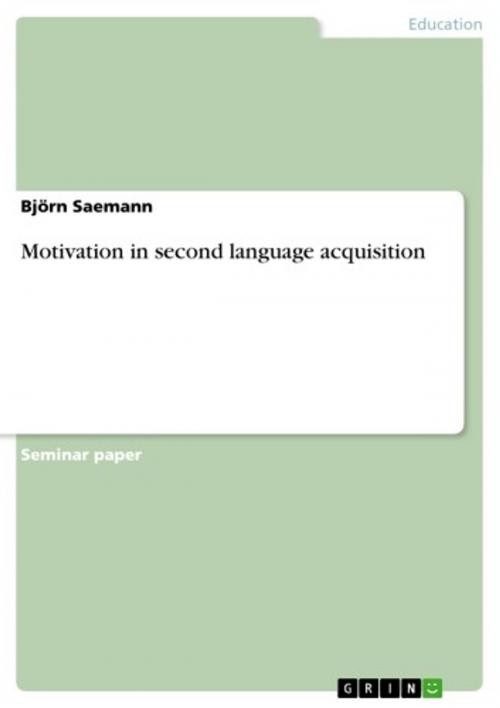Motivation in second language acquisition
Nonfiction, Reference & Language, Study Aids, ESL, Foreign Languages| Author: | Björn Saemann | ISBN: | 9783640333165 |
| Publisher: | GRIN Verlag | Publication: | May 26, 2009 |
| Imprint: | GRIN Verlag | Language: | English |
| Author: | Björn Saemann |
| ISBN: | 9783640333165 |
| Publisher: | GRIN Verlag |
| Publication: | May 26, 2009 |
| Imprint: | GRIN Verlag |
| Language: | English |
Seminar paper from the year 2009 in the subject English - Pedagogy, Didactics, Literature Studies, grade: 1,3, University of Hildesheim (Englisch als Fremdsprache), course: Language Acquisition, language: English, abstract: This paper is about motivation in second language acquisition. First the term 'motivation' will be defined and explained. Afterwards this paper will explain what different kinds of motivation exist and how they help to learn language. I will focus on the work of Rod Ellis and Robert C. Gardner as well as the works of Kimberly A. Noels. The final part of the paper will discuss motivation in the classroom and how to improve the motivation of students as a teacher. For this part I will focuse on the works of J. Brophy. Motivation is often named together with aptitude. Therefore it is vital to define the difference between aptitude and motivation. Ellis (2008:75) states while aptitude describes the 'cognitive abilities that underlie successful L2 acquisition, motivation involves the attitudes and affective states that influence the degree of effort that learners make to learn an L2'. So aptitude is a more or less stable component which the individual can not directly interfere with. Motivation on the other hand is a component that can change comparatively fast and can be altered by the learner himself. Gardner (2001) writes that motivation describes the driving force behind the effort of a learner. Motivation consists of three elements. The first element is 'effort'. A more motivated learner will put more effort in his or her studies. He will be open to do extra work in order to improve his language skills, spend more time with studying for the language and even deal with the subject on a subconscious level. [...]
Seminar paper from the year 2009 in the subject English - Pedagogy, Didactics, Literature Studies, grade: 1,3, University of Hildesheim (Englisch als Fremdsprache), course: Language Acquisition, language: English, abstract: This paper is about motivation in second language acquisition. First the term 'motivation' will be defined and explained. Afterwards this paper will explain what different kinds of motivation exist and how they help to learn language. I will focus on the work of Rod Ellis and Robert C. Gardner as well as the works of Kimberly A. Noels. The final part of the paper will discuss motivation in the classroom and how to improve the motivation of students as a teacher. For this part I will focuse on the works of J. Brophy. Motivation is often named together with aptitude. Therefore it is vital to define the difference between aptitude and motivation. Ellis (2008:75) states while aptitude describes the 'cognitive abilities that underlie successful L2 acquisition, motivation involves the attitudes and affective states that influence the degree of effort that learners make to learn an L2'. So aptitude is a more or less stable component which the individual can not directly interfere with. Motivation on the other hand is a component that can change comparatively fast and can be altered by the learner himself. Gardner (2001) writes that motivation describes the driving force behind the effort of a learner. Motivation consists of three elements. The first element is 'effort'. A more motivated learner will put more effort in his or her studies. He will be open to do extra work in order to improve his language skills, spend more time with studying for the language and even deal with the subject on a subconscious level. [...]















